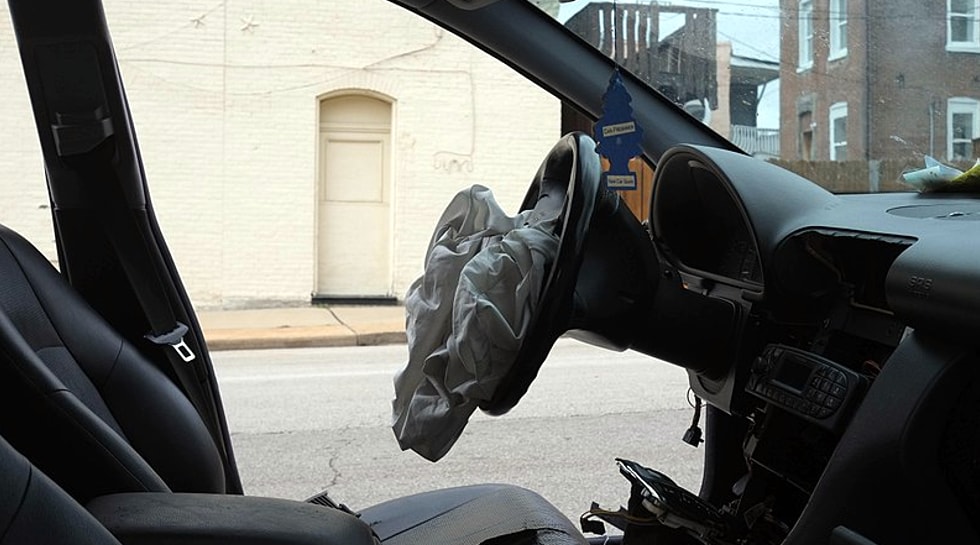Several years ago on Maui, I had my first intimate experience with airbags.
We were two couples on vacation. Our friends were in the front seats of our flyweight Chevy Cavalier; my wife and I were in the back. We were relaxed, heading back to our digs for dinner. As we approached our condo, we needed to make a left turn, which required crossing three lanes of oncoming traffic. The traffic light turned yellow just as we were about to do so. We were in the middle of the intersection, so we started into our turn.
I was somewhat surprised to find I was still alive. After the initial shock, the first thing I noticed what I took to be smoke inside the car, “Yikes! Fire!” I thought. I jumped out and checked the other three occupants; they were thoroughly shaken-up, but not obviously injured. Chaos reigned in the intersection for a time, but eventually things got sorted out. I saw that both front airbags had gone off properly – pretty good for an econobox, I remember thinking.
The car itself was totalled. The noble Cavalier was dragged off to its final reward – likely a crusher in Honolulu. The airbags surely prevented severe injury to our friends in the front seat. In passing, I thought what a genius-grade invention the airbag was. Thinking it over, I concluded that because these bags are hidden, most people don’t give them a particle of respect. This, I submit, needs to change.

Because of my lunatic curiosity I decided to delve into this rather arcane subject. Let me set out some interesting things I’ve learned about the common airbag – also, of course, known as the Supplemental Restraint System (SRS). How about this? In a recent decade, air bags were deployed 3.3 million times in the U.S., saving over 6,000 lives. When you think about it, it seems fair to say that not many inventions in human history have achieved so much.
Historical Highlights
- 1968: Allen Breed, of Breed Technologies, Lakeland, Florida invented a crash-sensor and firing mechanism from which our modern airbags have developed.
- 1971: The Ford Motor Company built an experimental fleet of airbag-equipped cars. These early airbags used compressed air.
- 1973: The Oldsmobile Toronado was the first airbag-equipped car offered to the public.
- 1975: Volvo conducted a grisly experiment to gauge the effect airbags had on unrestrained children in crashes. They used 24 pigs (!) instead of kids. Sadly, eight of the pigs were snuffed; three were OK, but likely pretty put out. Make of that what you will; I wonder who was driving.
- 1984: Airbags were offered as an option on the innovative Ford Tempo.
- 1988: Chrysler introduced airbags as standard equipment.
- 1998: Brought brought a breakthrough in airbag design by TRW Automotive of Lavonia, Michigan, using an an electrochemical reaction to produce nitrogen, making older compressed-air devices obsolete.
- 2013-17: It was discovered that Japanese autoparts giant Tanaka had produced some defective airbag inflators at their plant in Coahuila, Mexico, resulting in casualties from shrapnel released when the bags inflated. This led to the recall of some 42 million cars – the largest recall in U.S. history. Tanaka went bankrupt as a result.
How It Works
We’ll use you and your car as an example, if you don’t mind. Airbags may be located in your steering wheel, dashboard, door, roof or seat. Inflation is triggered by ‘crash sensors’ embedded at strategic points around the perimeter of your car.
The sensor is activated when your car hits something immovable, say a tree, at ~15 mph or more. The sensor sends an electrical signal to an ignitor which instantly detonates a propellant – sodium azide – under the bag. In a mere 0.03 seconds, 67 litres of nitrogen rushes into the bag. Then, just 0.05 seconds after impact, your head and chest hit the bag. The force of this causes the bag to deflate. The deflated bag now gives you space so you can spring out of your car. By the way, the time from impact to inflation is less than half the time it takes to blink your eye.

Recent Progress
Several car companies have designed a “pedestrian” airbag on the outside of the vehicle that deploys if the vehicle strikes a pedestrian. The Volvo V40 was the first model to provide this as standard equipment in 2012. GM patented such a feature in 2018. Google is reported to be equipping its self-driving car with them too.
Potential Applications
Possible applications are many, of course; manufacturers are considering putting them in aircraft, buses and trains. Motorcyclists can now get an air-jacket that inflates when the rider is thrown off. Something similar might be used in the equestrian world.
And I really like this: architects are working on incorporating airbags into elevators. How about into bathrooms and at the bottom of staircases to offset injuries from falls in the elderly?
I’ve always wondered if the airbags in my older vehicles were up to the job, or if they’ve quietly expired. Well, I’ve consulted experts, and I’m told that when I turn on my ignition and the SRS light comes on for 7-10 seconds, and then goes out – all is well. Airbags normally require no maintenance. The Volvo company bravely asserts that their airbags will last the “lifetime of the car”. Volvo’s attention to safety and quality explains my family’s loyalty to the brand.Volvo was my first car, and I’ve been driving ‘Swedish Iron’ for fifty years and have no plans to quit.
And so, my friends, let’s give a cheer and a vote of respect for the amazing airbag. It just might save your life or mine sometime soon. And now, with your newfound respect for the airbag, I bet you’ll enjoy the attached video.






Facebook Comments